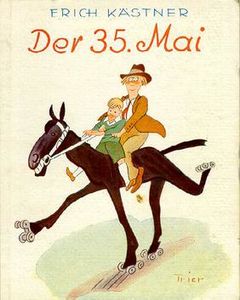The 35th of May, or Conrad's Ride to the South Seas facts for kids
 |
|
| Author | Erich Kästner |
|---|---|
| Original title | Der 35. Mai oder Konrad reitet in die Südsee |
| Illustrator | Walter Trier (later editions - Horst Lemke). |
| Country | Germany |
| Language | German |
| Genre | Children's novel |
| Publisher | New English Library |
|
Publication date
|
1931 |
| Media type | Print (Hardback & Paperback) |
| Pages | 192 pp. |
| ISBN | 978-0-224-60363-8 |
| OCLC | 123753039 |
The 35th of May, or Conrad's Ride to the South Seas is a fun fantasy novel. It was written by Erich Kästner and first published in 1931. The book's original German title is Der 35. Mai oder Konrad reitet in die Südsee. Unlike many of Kästner's other stories, which are set in real places, this one takes you on a wild, imaginative adventure. It's full of magic and humor!
Contents
What is The 35th of May About?
This exciting story follows a young boy named Conrad. Every Thursday, Conrad spends time with his uncle, Mr. Ringelhuth. One special Thursday, which happens to be the "35th of May," something amazing happens.
Meeting a Magical Horse
Conrad and his uncle meet a talking black horse named Negro Caballo. This isn't just any horse! Negro Caballo is super smart and knows a lot about books. Plus, he's the best roller skater in the whole world!
Journey Through a Magic Wardrobe
Together, Conrad, Mr. Ringelhuth, and Negro Caballo step into a huge wardrobe. This wardrobe isn't ordinary; it's a secret door to many magical lands! Their adventure begins in the land of Cockaigne, a place where everything is easy and fun.
Exploring Fantastic Worlds
Their journey takes them to many incredible places:
- A medieval castle with knights and jousting tournaments.
- An upside-down world where kids are in charge. In this world, children can even send grown-ups to a special school if they misbehave!
- A futuristic city that feels like a science fiction dream. It has moving walkways and early versions of mobile phones.
- Finally, they reach a beautiful South Sea island.
Returning Home and Sharing the Story
After all their amazing adventures, Conrad and his companions return to the real world. Conrad then writes a school essay about everything he experienced. Imagine trying to explain that to your teacher!
Inspiration for Other Fantasy Stories
The idea of entering magical worlds through a wardrobe might sound familiar. This book used the idea long before other famous stories.
The Magic Wardrobe Idea
The way Conrad enters magical lands through a wardrobe is similar to how characters in other books do. For example, C. S. Lewis used a similar idea in his famous book, The Lion, the Witch and the Wardrobe.
Earlier Wardrobe Adventures
Even before Kästner's book, the author E. Nesbit wrote a short story in 1912. It was called "The Aunt and Amabel." In that story, a girl also finds a magic world by going through a wardrobe. Many people believe these earlier stories inspired later authors.

